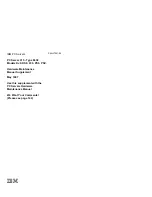
Remote System Management
4–4 Compaq ES40CSLP Rackmount System Installation/User/Service Guide
Figure 4-2 Data Flow in Bypass Mode
Modem
System
SRM/AlphaBIOS
Consoles
Operating System
RMC Modem
Port (Remote)
Local Serial Terminal
(MMJ Port)
Modem
LJ-06636A
RMC>
RMC>
Remote Serial Terminal
or Terminal Emulator
COM1
COM1 Port
UART
Modem Port
UART
RMC PIC
Processor
Bypass
RMC COM1
Port (Local)
DUART
UART
Snoop Mode
In snoop mode data partially bypasses the RMC. The data and control signals are routed
directly between the system COM1 port and the external modem port, but the RMC taps into
the data lines and listens passively for the RMC escape sequence. If it detects the escape
sequence, it enters the RMC CLI.
The escape sequence is also passed to the system on the bypassed data lines. If you decide to
change the default escape sequence, be sure to choose a unique sequence so that the system
software does not interpret characters intended for the RMC.
In snoop mode the RMC is responsible for configuring the modem for dial-in as well as dial-
out alerts and for monitoring the modem connectivity. Because data passes directly between the
two UART ports, snoop mode is useful when you want to monitor the system but also ensure
optimum COM1 performance.
Soft Bypass Mode
In soft bypass mode all data and control signals are routed directly between the system COM1
port and the external modem port, and the RMC does not listen to the traffic on the COM1 data
lines. The RMC is responsible for configuring the modem and monitoring the modem
connectivity. If the RMC detects loss of carrier or the system loses power, it switches
automatically into snoop mode. If you have set up the dial-out alert feature, the RMC pages the
operator if an alert is detected and the modem line is not in use.
Soft bypass mode is useful if management applications need the COM1 channel to perform a
binary download, because it ensures that RMC does not accidentally interpret some binary data
as the escape sequence. After downloading binary files, you can set the com1_mode
environment variable from the SRM console to switch back to snoop mode or other modes for
accessing the RMC, or you can hang up the current modem session and reconnect it.
Firm Bypass Mode
In firm bypass mode all data and control signals are routed directly between the system COM1
port and the external modem port. The RMC does not configure or monitor the modem. Firm
bypass mode is useful if you want the system, not the RMC, to fully control the modem port
and you want to disable RMC remote management features such as remote dial-in and dial-out
alert. You can switch to other modes by resetting the com1_mode environment variable from
the SRM console, but you must then set up the RMC again from the local terminal.
Содержание ES40CSLP
Страница 10: ...This is some white text...
Страница 14: ...This is some white text...
Страница 46: ...This is some white text...
Страница 80: ...This is some white text...
Страница 98: ...This is some white text...
Страница 126: ...This is some white text...
Страница 188: ...This is some white text...
Страница 190: ...This is some white text...
















































